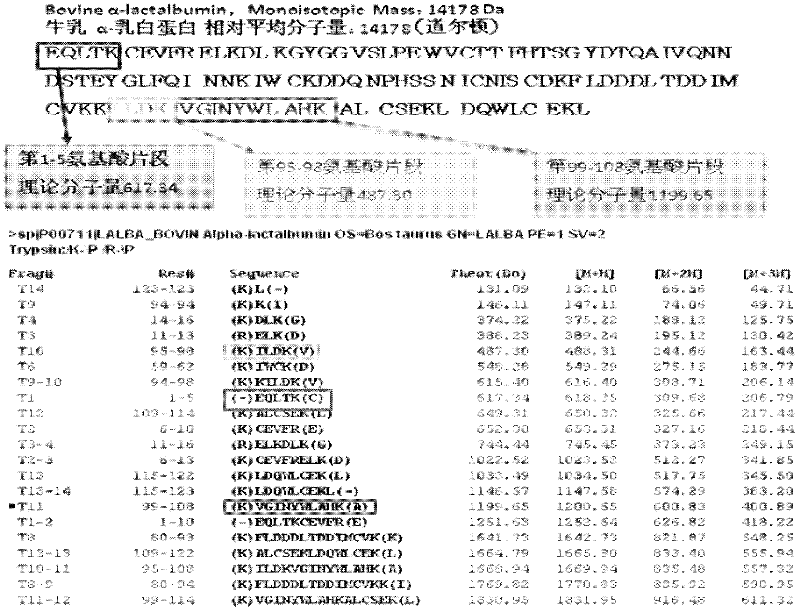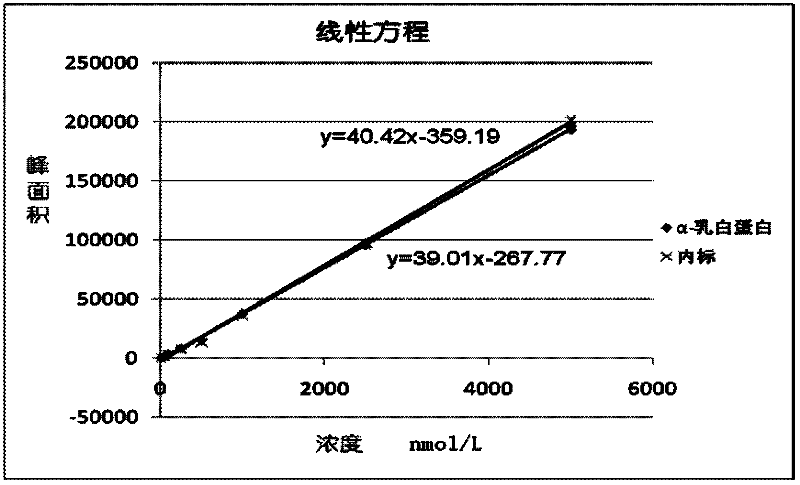Quantitative detection method for bovine alpha-lactalbumin
A quantitative detection method and technology for lactalbumin, applied in measurement devices, instruments, scientific instruments, etc., can solve the problem of not finding thermally denatured and non-denatured bovine α-lactalbumin, not establishing an accurate and effective evaluation and detection method, and unable to measure bovine α-lactalbumin. α-lactalbumin and other problems, to meet the requirements of large-scale sample detection, fast sample analysis, and simple sample processing.
- Summary
- Abstract
- Description
- Claims
- Application Information
AI Technical Summary
Problems solved by technology
Method used
Image
Examples
Embodiment 1
[0032] 1. Optimization of enzymatic hydrolysis conditions
[0033] The enzymolysis conditions refer to the reaction temperature and time after sample dissolution, adding dithiothreitol (DTT), the reaction environment and time after adding iodoacetamide (IAA), and the enzymolysis after adding trypsin Temperature, pH value and time etc.; The invented method utilizes trypsin to only act on the specificity of arginine (R) and lysine (K), and whey protease is cut into molecular weight from tens to thousands of daals Peptide molecules, and then select only the characteristic peptide molecules unique to bovine α-lactalbumin as qualitative and quantitative target peptides. The final optimization method is: take 1-2 g of homogeneity sample, dilute with water to prepare a solution with a total protein content of about 1 mg / mL, then accurately draw 500 μL, add 20 μL of internal standard and 480 μL of NH 4 HCO 3 solution, add 10 μL DTT solution, keep the temperature at 50°C for 30 minut...
Embodiment 2
[0055] Sample type: Raw milk.
[0056] Take 36ml of fresh milk, divide it into 12 tubes×2 groups on average, each tube is 3ml, and then heat it in an 80°C incubator. The heating time of each tube in the same group is 0, 15, 30, 40, 50, 60, 70, 80, 90, 100, 110, 120min, the heat-treated samples were left to room temperature, and the two groups of samples were processed as follows:
[0057] ① Method in the literature: Accurately weigh 1.0 g heat-treated sample, add 500 μL human milk internal standard solution, dilute to 9 ml with 0.3 mol / L NaCl solution containing 0.2% Triton X-100, adjust pH value to 4.6, fixed solution to 10ml, homogenized extraction for 10min, let stand for 30min, take 2ml solution in a centrifuge tube, centrifuge at 15000r / min for 15min, take the clear night through a 0.22μm filter membrane, inject the sample, and analyze and detect in the selected interval scanning mode , the scanning interval of bovine α-lactalbumin is 2357~2367m / z, the scanning interval ...
Embodiment 3
[0060] Sample type: Commercial infant formula milk powder.
[0061] Weigh 1.0g of the sample into a 100mL volumetric flask, add warm water to dissolve, wait until it cools to room temperature, add water to make up to the mark, accurately draw 500μL, add 20μL 25μmol / L internal standard and 480μL 500mmol / L NH 4 HCO 3 solution, add 10μL 500mmol / L DTT solution, keep the temperature at 50°C for 30 minutes, take it out and cool it to room temperature, add 30μL 500mmol / L IAA solution, let it stand in the dark for 30 minutes, add 10μL 100mmol / L CaCl 2 Solution and 30 μL 100 μg / mL trypsin solution, 37 ℃ constant temperature for overnight enzymolysis, take out the next day and add 20 μL pure formic acid, let it stand at room temperature for 1 hour, and finally dilute the enzymolysis solution to 2mL, take the obtained sample solution according to the method of Example 1 Enter mass spectrometry, and use the internal standard method to calculate the result (linear equation is y=38.36x+209...
PUM
 Login to View More
Login to View More Abstract
Description
Claims
Application Information
 Login to View More
Login to View More - R&D
- Intellectual Property
- Life Sciences
- Materials
- Tech Scout
- Unparalleled Data Quality
- Higher Quality Content
- 60% Fewer Hallucinations
Browse by: Latest US Patents, China's latest patents, Technical Efficacy Thesaurus, Application Domain, Technology Topic, Popular Technical Reports.
© 2025 PatSnap. All rights reserved.Legal|Privacy policy|Modern Slavery Act Transparency Statement|Sitemap|About US| Contact US: help@patsnap.com



